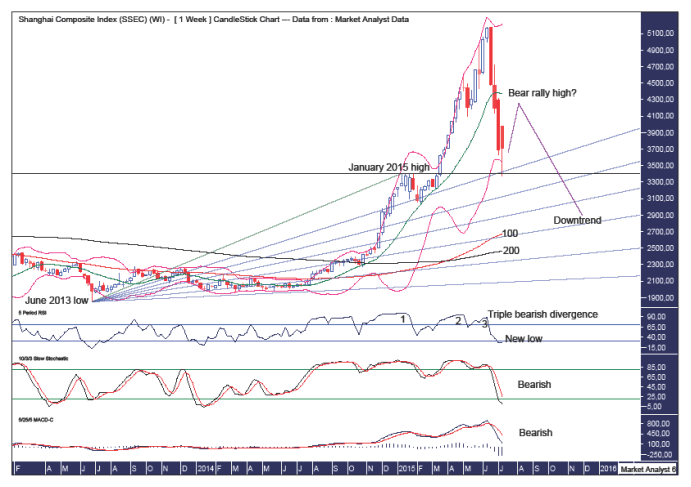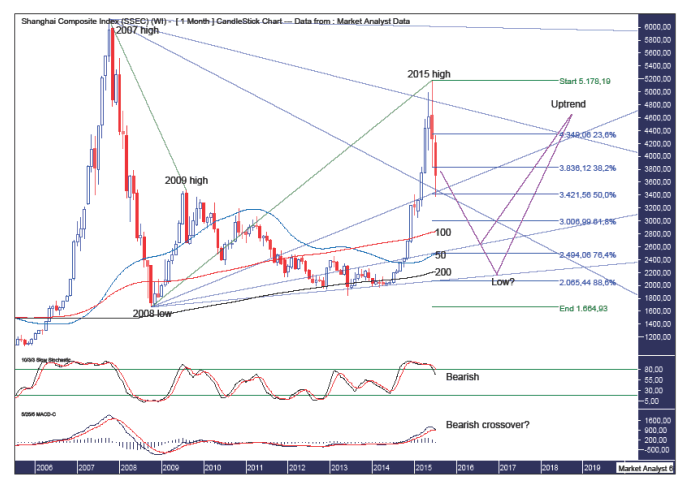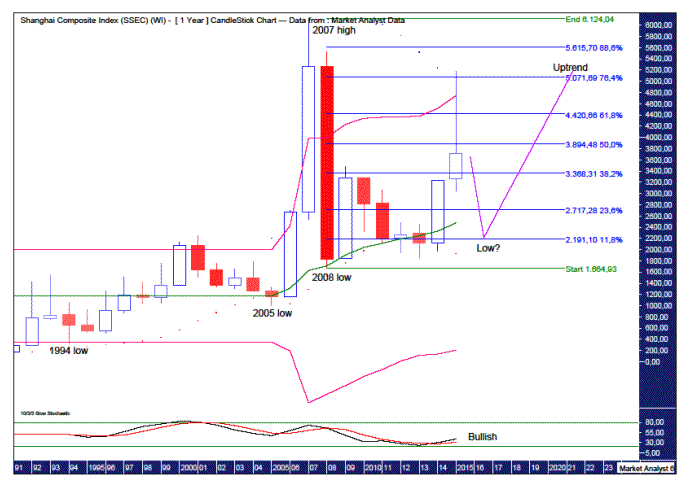Where Is The Chinese Stocks Bear Market Likely To End?
Stock-Markets / Chinese Stock Market Jul 10, 2015 - 06:12 PM GMTBy: Austin_Galt
 With the Chinese stock market, known as the Shanghai Stock Exchange Composite (SSEC) plunging in recent weeks, I thought I would analyse the technicals to determine where the final low to this bear market is likely to be.
With the Chinese stock market, known as the Shanghai Stock Exchange Composite (SSEC) plunging in recent weeks, I thought I would analyse the technicals to determine where the final low to this bear market is likely to be.
Let’s begin by reviewing the more immediate picture with the weekly chart before zooming out and looking at the bigger picture with the monthly and yearly charts.
SSEC WEEKLY CHART

We can see the recent high was accompanied by a triple bearish divergence on the RSI. This often leads to a significant decline and that has been an understatement here. This indicator is now showing new lows which is bearish in that the final low is likely to show at least one bullish divergence.
The Stochastic and MACD indicators are both trending down and looking bearish indicating the likelihood of lower prices going forward.
However, there looks to be some short term relief in store right now. Why?
The Bollinger Bands show price is down at support from the lower band. The first time price hits this lower band often leads to a bounce back up to the middle band where resistance comes in again. This is what I favour happening here and that after price hits the middle band the downtrend will resume which sees price trade even lower.
Also, I have drawn a Fibonacci Fan from the June 2013 low to the January 2015 high. We can see the first little pullback after that January 2015 high found support at the 23.6% angle. Price looks to have once again found support at this angle. Once the bear rally high is in place then the downtrend should resume which sees price makes its way through these angles finding support and resistance along the way.
I have drawn a horizontal line denoting the January 2015 high at 3404. Old tops often provide support in the future and, hey presto, this week’s low at 3373 was right in the mix.
Finally, I have added moving averages with time periods of 100 (red) and 200 (black) which are in bullish order with the red line above the black line. This signifies an overall bullish condition despite the recent plunge. Something to keep in mind for those taking a longer term view!
Now let’s check out the bigger picture beginning with the monthly chart.
SSEC MONTHLY CHART

The Stochastic indicator is bearish while the MACD looks to be threatening a bearish crossover which I expect will occur once a little bear rally from here is over.
I have added some Fibonacci Fan angles using the 2008 low and 2007 high as starting points. Let’s run through them.
Firstly, the recent high was at resistance from the 88.6% angle down from the 2007 high.
We can see price just hit a low where the 50% angle up from the 2008 low intersects with the 76.4% angle down from the 2007 high. Nice.
As for final low targets, I am favouring price coming all the way back to the 88.6% angle up from the 2008 low. The 76.4% angle will be another to watch closely.
I have added Fibonacci retracement levels of the move up from 2008 low to 2015 high and I am favouring the final bear market low to get back to at least the 76.4% level at 2494 while the 88.6% level at 2065 may be a tad too far. Let’s see.
The moving averages I have added are interesting. They include averages with time periods of 50 (blue), 100 (red) and 200 (black). The black line is below both others indicating the long term position of the market to be bullish. Interestingly, the blue line is below the red line and the market exploded higher this year despite this bearish condition. It really is no surprise to see price come back to earth with the averages presented this way. But be under no illusion. These averages looks very bullish over the longer term and the move up this year should help to see the blue line get back up above the red line. Once all three averages are in bullish order, then the market should truly explode higher with conviction. All in good time.
SSEC YEARLY CHART

The yearly chart shows a massive bull market still in play with a pattern of higher highs and higher lows.
The Bollinger Bands show the recent high traded well above the upper band which is a common occurrence at solid tops. I now expect the final low to be back at support from the middle band which is currently around 2475.
The PSAR indicator now has a bullish bias after price busted the dots on the upside this year. As often happens, price then comes back to test the support given by this indicator with the dots now on the downside.
I have added Fibonacci retracement levels of the move down from the 2007 high to 2008 low. The recent high was at resistance from the 76.4% level and I suspect price will eventually bottom out down near the 11.8% level which stands at 2191.
The Stochastic indicator is bullish.
Summing up, while there looks to be further downside over the next year or so, the massive bull market remains solid which should see the upside resume in a couple of years.
By Austin Galt
Austin Galt is The Voodoo Analyst. I have studied charts for over 20 years and am currently a private trader. Several years ago I worked as a licensed advisor with a well known Australian stock broker. While there was an abundance of fundamental analysts, there seemed to be a dearth of technical analysts. My aim here is to provide my view of technical analysis that is both intriguing and misunderstood by many. I like to refer to it as the black magic of stock market analysis.
Email - info@thevoodooanalyst.com
© 2015 Copyright The Voodoo Analyst - All Rights Reserved
Disclaimer: The above is a matter of opinion provided for general information purposes only and is not intended as investment advice. Information and analysis above are derived from sources and utilising methods believed to be reliable, but we cannot accept responsibility for any losses you may incur as a result of this analysis. Individuals should consult with their personal financial advisors.
Austin Galt Archive |
© 2005-2022 http://www.MarketOracle.co.uk - The Market Oracle is a FREE Daily Financial Markets Analysis & Forecasting online publication.



